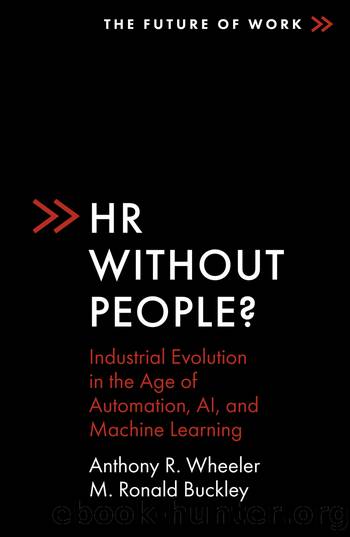HR Without People? by Wheeler Anthony R.; Buckley M. Ronald;

Author:Wheeler, Anthony R.; Buckley, M. Ronald;
Language: eng
Format: epub
Publisher: Emerald Publishing Limited
Published: 2019-09-25T00:00:00+00:00
7
A Century of Stress Headed into the Next Century
From a change perspective, the current century will feel like no other century in recorded history. This sounds hyperbolic, and perhaps it is. Consider, however, the cumulative effect of what will have occurred. Instantaneous, real-time communication via the integration of traditional media â newspapers, broadcast journalism â and citizen journalism and social media tweets, Facebook posts, uploads from citizens' phones, and constant on-air reporting break news within seconds of an event occurring. The technologies of the Fourth Industrial Revolution will unevenly disrupt jobs, industries, economies, and societies across the globe. Millions of years of human evolution have imbued within our species the importance of work in defining who we are, yet machines will displace so much human work over a brief hundred-year time period. Climate change and a new era of global pandemics will roil nations across the globe and be reported in real time. New industries will emerge while traditional industries will wane and, for some, cease to exist. It will be a lot for humans to take in over such a brief period of time, and it will be broadcasted live and in real-time across phones, tablets, wearable technology, television screens, and radio streaming services.
We deliberately use the word feel when describing the likely unprecedented changes occurring over the twenty-first century into the twenty-second century. History, of course, teaches us that every century contains advancements and events that force species to adapt. The twentieth century contained two world wars that fundamentally altered the world. Nineteenth century Victorian notions of chivalry and class were obliterated in the muddy trenches and front lines of places like Verdun, Ypres, and the Argonne Forest. Tanks, weaponized airplanes, and gruesome new weapons were all invented and deployed to break through miles of trenches and barbed wire. The Spanish flu pandemic swept across the war-torn world, killing more people than the Great War did. The redrawn postâWorld War I boundaries created new nations in the Middle East, divvying up the spoils of war from a collapsed trio of axis nations and seeding a deep discontent among some in the defeated nations. Russia experienced a revolution that saw the creation of a new type of government that would become an ideological and later military competitor to democratic nations around the world. A postwar economic boom ended in the deepest economic depression that conspired to create an environment where previous resentments and technological advances led to a second world war. The invention of the atomic bomb formally ended World War II, which led to a decade of relative global peace and prosperity. Weary of world conflagrations but eager to expand influence, the world's two postâWorld War II powers engaged in a global cold war. Two long and costly wars in Asia and a missile crisis in the Caribbean kept the world on edge as technological innovations, many of which were developed during the century's wars, rapidly spread across the globe. As the end of the twentieth century approached,
Download
This site does not store any files on its server. We only index and link to content provided by other sites. Please contact the content providers to delete copyright contents if any and email us, we'll remove relevant links or contents immediately.
Bullshit Jobs by David Graeber(3180)
Radical Candor by Kim Scott(2216)
I Am Right, You Are Wrong by Edward De Bono(2108)
23:27 by H. L. Roberts(1893)
Nomadland by Jessica Bruder(1684)
Average Is Over by Tyler Cowen(1542)
High-Impact Interview Questions by Victoria A. Hoevemeyer(1403)
Out of Our Minds: Learning to Be Creative by Ken Robinson(1380)
The Conflict Resolution Phrase Book by Barbara Mitchell & Cornelia Gamlem(1342)
The Ideal Team Player by Patrick M. Lencioni(1317)
The Asshole Survival Guide by Robert I. Sutton(1283)
An Everyone Culture: Becoming a Deliberately Developmental Organization by Robert Kegan & Lisa Laskow Lahey(1282)
Automatic Society by Bernard Stiegler(1220)
Unleashed by Anne Morriss & Frances Frei(1220)
Who by Street Randy & Smart Geoff(1200)
42 Rules of Employee Engagement by Susan Stamm(1191)
Who Moved My Cheese?: An Amazing Way to Deal With Change in Your Work and in Your Life by Johnson Spencer(1178)
96 Great Interview Questions to Ask Before You Hire by Paul Falcone(1132)
The Power of Disability by Al Etmanski(1083)
